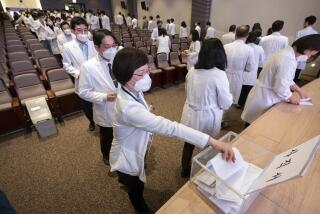Korean to a tee
- Share via
SOUTH KOREA’S 7-3 victory over the United States in the World Baseball Classic on Tuesday wasn’t the only sporting news that made front-page headlines in Seoul last week. On the same day that the South Korean team “spanked the U.S.” -- as the English-language edition of the Korea Times put it -- the nation’s prime minister was forced to resign after it was revealed that he had played golf with some shady businessmen on a national holiday that coincided with the start of a crippling national rail strike.
If poor Lee Hae-chan had just gone hiking or even fishing, he’d probably still have his job. That’s because golf resonates in South Korea -- it’s all about power, prestige and corruption. It’s got clout in North Korea too. The state-run media likes to boast that the “Great Leader,” Kim Jong Il, makes three or four holes-in-one every time he plays.
And because golf is special in Korea, it’s special in Koreatown. Which begins to answer one of multicultural L.A.’s burning questions. What is it with Korean Americans and golf?
The Korean obsession with golf starts with the landscape. It isn’t easy to find flat, open space in a country that ranks as one of the mostly densely populated and mountainous in the world. As a result, golf is a lofty affair there. Though the popularity of the game is growing -- an estimated 2.5 million Koreans played in 2002 -- most golfers are restricted to driving ranges. There are only 50 public-access courses in the country, mostly attached to expensive resorts. The other 120 courses are in private clubs that only the upper crust can afford to join. The difficulty of getting a tee time on weekends has turned golf invitations into coveted favors.
South Korea’s golf fetish took off during the presidential administration of Roh Tae-woo (1988 to 1993), who became personally involved in the licensing of courses. Under his rule, Korean business conglomerates -- known as chaebol -- started building courses and invited government officials to play a round or two with lobbyists and the captains of industry. The golf courses became the place where high-level deals were made, and golf became a symbol not only of the corruption of the Roh administration but of the collusion between the government and big business.
Roh’s successor, reformer Kim Young-sam (1993 to 1998), pledged not to play golf during his presidency. His successor, Kim Dae-jung (1998 to 2003), was more accommodating toward the sport until his defense minister was found to have played during a national security alert.
When South Korea’s current president, Roh Moo-hyun, took office in 2003, he made a point of playing a round with key aides and Cabinet secretaries in an effort to remove the golf taboo among civil servants and business people. But as evidenced by Golfgate -- as the South Korean papers are calling Prime Minister Lee’s forced retirement -- the sport can’t completely shed its reputation as a pastime of the rich, famous and corrupt.
And yet fat-cat villains are hardly the only famous Korean players. In the 1990s, South Korea began to churn out a generation of great women professionals. In 1998, Se Ri-pak was LPGA rookie of the year. Last year, six of the top 15 players on the LPGA Tour and 21 of the top 100 moneymakers were Korean or of Korean descent.
So how does all this translate in the United States? Well, there’s Hawaii-born teenage sensation Michelle Wie staking the Korean American claim to golf fame and fortune. And there’s the general way the sport’s elite status at home feeds its appeal abroad. For Koreans in the U.S., though, golf loses its shady reputation, maybe because it’s so much more accessible. It’s as much a symbol of aspiration as it is of elitism.
According to Kyu Yang, publisher of Golf Champion, a bilingual magazine, most Korean American golfers begin playing only after they emigrate. “Immigrants want to be high-quality people,” he says, “and here it doesn’t cost that much money.”
In New York and Southern California, home to the nation’s largest Korean populations, a growing share of the players at municipal golf courses at, say, Long Island’s Bethpage State Park and L.A.’s Griffith Park are Korean. And plenty of Koreans are joining private suburban country clubs. Indeed, according to Yang, in Southern California an estimated 30 private courses are Korean-owned.
None of this completely unravels the mystery of the Korean connection with golf. Some say that golf is simply a convenient sport for an immigrant group with a high rate of self-employment and the ability to take off a few hours during the day to hit the links. Others believe it’s a way to feel part of the mainstream without needing to speak perfect English. One Korean golf columnist linked his countrywomen’s prowess to the dexterity developed by preparing traditional foods such as kimchi by hand. Sociologist Ken Shin at the University of South Carolina thinks that golf fits nicely into the national psyche because “Koreans love challenges.”
But the most compelling reason for the Korean obsession may come from Korean American novelist Chang-rae Lee. “Korean history is very tragic,” he told me. “It’s a tale of a country that hasn’t named its destiny because of its location and size. Golf is the confluence of exertion and control. It gives us the illusion that we control our destiny.”
More to Read
Go beyond the scoreboard
Get the latest on L.A.'s teams in the daily Sports Report newsletter.
You may occasionally receive promotional content from the Los Angeles Times.










